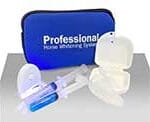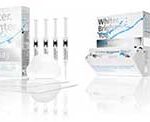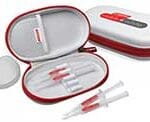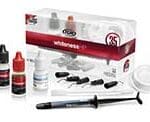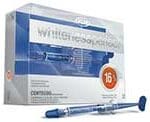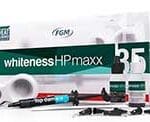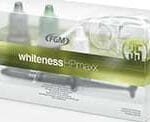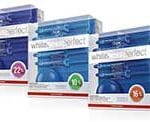Chemical reaction involved in tooth whitening procedure.
Dr. Goswami’s — Delhi Dental Center – one of the top specialized Laser Speed Teeth Whitening, tooth bleaching Treatment Dentist Dental Clinic in East Delhi India, welcome people looking for causes of tooth discoloration and chemical reaction involved in tooth whitening treatment procedures, Laser speed Dental-Tooth-Teeth whitening or Dental Bleaching procedures for their stained or dis-coloured teeth.

The Basic Idea about why our teeth get stains on them
Before we get into the details of tooth-whitening, let’s take a minute to meet the enemy. What are tooth stains anyway?
Each of your teeth is made up of an inner dentin layer and a hard outer enamel layer, which protects the teeth. When you put stuff in your mouth — food, cigarette smoke, coffee, etc. — another layer gradually forms on top of the enamel layer. Basically, the foreign material accumulates to form a pellicle film over the enamel layer.
A dentist can clean away this film, through scraping and chemical treatments. Even brushing your teeth can knock out some of it — brushing with the abrasive toothpaste cleans the tooth in the same sort of way scrubbing with an abrasive pad cleans a dish. “Whitening toothpastes” are designed to work even harder on this layer.
The problem is, as this pellicle layer sits on your teeth for years and years, the foreign material gets into the enamel. The enamel layer is made up of hydroxyapatite crystals, which form microscopic hexagonal “rods.” Simply put, enamel is porous, which means staining agents can work their way down into the tooth, where you can’t simply scour them away. The deeper stains are basically harmless, but many people find them unattractive.
Now as you see — causes of tooth discoloration can be categorized into two main groups: Intrinsic staining & extrinsic staining.
- Intrinsic staining — sometimes called internal staining, can be attributed to factors such as genetics, age (from enamel wear over time exposing yellower dentin), antibiotics, high levels of fluoride, and developmental disorders and can start before the tooth has erupted. After eruption of the tooth some dental restorations can cause tooth staining.
- Extrinsic staining — sometimes called external staining, is largely due to environmental factors including smoking, pigments in beverages and foods, antibiotics, and metals such as iron or copper. Colored compounds from these sources are adsorbed into acquired dental pellicle or directly onto the surface of the tooth causing a stain to appear.
Now this is where true tooth whiteners or Dental tooth whiteners or Dental tooth Bleaching treatment procedures comes in. Basically, the whiteners use bleaching chemicals to get down into the tooth enamel and set off a chemical reaction (specifically, an oxidation reaction) that breaks apart the staining compounds.
Most tooth whiteners use one of two chemical agents: Carbamide peroxide or Hydrogen peroxide (the same stuff that will bleach your hair). When used in the mouth, carbamide peroxide breaks down into hydrogen peroxide and urea, with hydrogen peroxide being the active whitening ingredient.
There are a number of different ways of setting off this basic process. Let’s look at the main options.
Teeth Whitening chemistry process –
Tooth whitening is any process that lightens the colour of a tooth. Whitening may be accomplished by physical removal of the stain or a chemical reaction to lighten the tooth colour. Bleaching is defined here as the chemical degradation of the chromogens. The active ingredient in most whitening products is hydrogen peroxide (H2O2) which is delivered as hydrogen peroxide or carbamide peroxide. Carbamide peroxide is a stable complex that breaks down in contact with water to release hydrogen peroxide. Because carbamide peroxide releases hydrogen peroxide the chemistry of most tooth whitening is that of hydrogen peroxide.
Tooth stains consist of compounds that have colour or darker shades called chromogens that are accumulated in the tooth (Intrinsic) or on the tooth (Extrinsic). Chromogens fall into two categories: large organic compounds that have conjugated double bonds in their chemical structure and metal containing compounds.
- Bleaching of the organic compounds by hydrogen peroxide involves reacting with the double bonds to oxidize the double bond. This causes the chromogen to become a lighter coloured compound.
Bleaching of the metallic compounds is much more difficult; better aesthetic options may be veneers, bonding, or crowns. There are some professional products that contain sodium hypochlorite (NaOCl) which reacts with the double bonds of the chromogen in much the same way as peroxide.
How Tooth Whitening Works
- In-office Dentist Supervised Whitening procedures
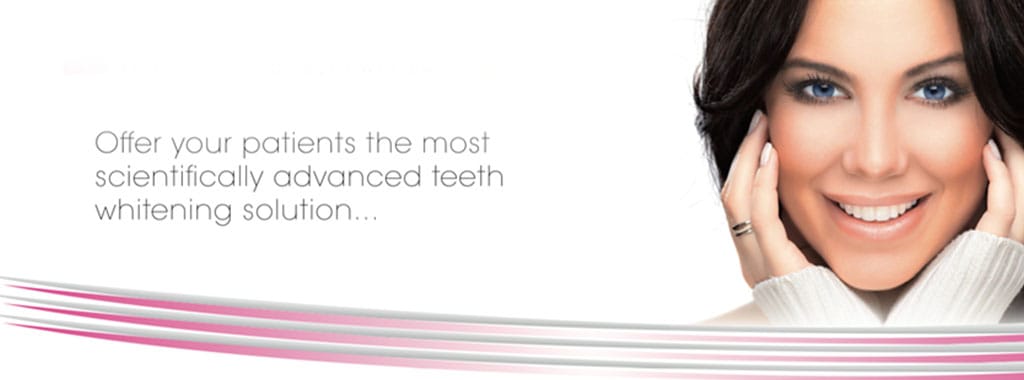
Dentist-supervised tooth whitening involves the controlled use of Carbamide or Hydrogen peroxide, tailored to a particular patient. Dentists may administer in-office treatments or at-home treatments.
At Delhi Dental Center, before we start our tooth whitening treatment, Cosmetic Delhi dentists clean the teeth, fill any cavities, and make sure the patient’s gums are healthy.
Most of our in-office systems use 15 to 35 percent hydrogen peroxide gels, always coupled with a high intensity light to expedite the bleaching chemical reaction.
The in-office procedure involves the whitening dentist gently cleaning your teeth with pumice and then putting a protective barrier on the gums. Our smile designing Delhi dentist then places hydrogen peroxide paste on the teeth for ten minutes per cycle, rinses it off, and usually reapplies it three to four times. The procedure can achieve about four to six shades of whitening after only one 40-minute treatment.
- At Home Teeth Bleaching treatment procedure –
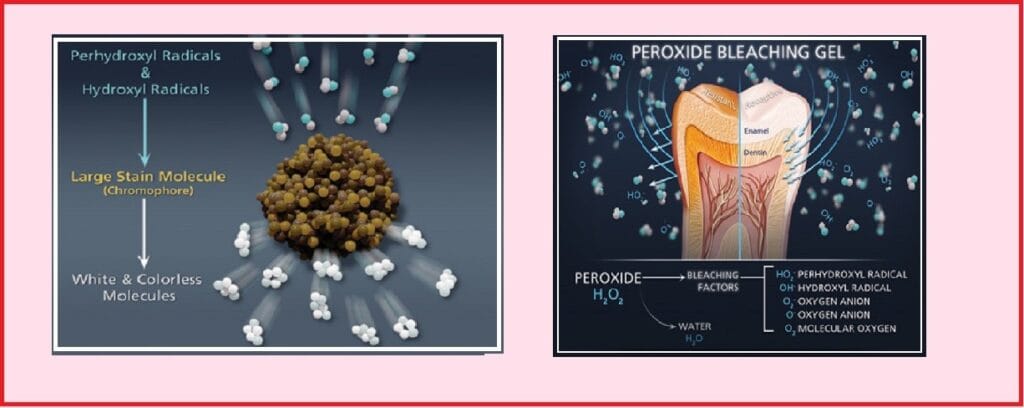
At-home systems will often use 10 to 20 percent Carbamide peroxide gels that also contain glycerin, carbomer, sodium hydroxide, water, and flavoring agents. Some gels that contain more than 10 percent carbamide peroxide will also include sodium fluoride to reduce sensitivity and strengthen teeth.
To begin the at-home procedure, our whitening dentist takes impressions (molds) of your mouth, and then has soft, custom mouth trays made. To administer the treatment, the you put a thin ribbon of the gel into the tray and wears it for two hours during the day, or while sleeping. Most whitening occurs in one to two weeks. In difficult cases, trays may need to be worn for up to six weeks.
A combination of in-office and at-home systems can achieve up to 12 to 15 shades of whitening in most patients. At-home systems used alone can obtain similar results, but may take longer. These procedures are considered safe and effective when monitored by a dentist.
Advantages of In-office tooth whitening
Dentist supervised systems have advantages and disadvantages when compared to over-the-counter tooth whitening products. The main advantage of the dentist supervised system is that the dentist can help determine if tooth whitening should be performed and if it will be effective for the patient. Patients with decayed teeth, infected gums, white spots on their teeth, and multiple tooth colored fillings or crowns (caps) on the front teeth may not be good candidates for tooth whitening.
The dentist can also help decide what type of tooth whitening is required (in-office, at-home or both) and the concentration of the whitening gels. The dentist can monitor and treat patients who experience sensitivity to the whitening agents and modify the procedure for those who are having difficulty getting optimal results. Finally, the dentist can help the patient explore other cosmetic dental treatment options such as porcelain or resin veneers, tooth colored fillings, gum lifts and tooth shaping used with or without tooth whitening. With the help of the dentist, the patient’s cosmetic dental goals may be more easily attained.
The disadvantages of dentist supervised whitening systems include higher cost and longer time required to get started. The in-office and at-home tooth whitening systems can cost between 150 to 200 USD $ (sometimes more). In most cases, at-home systems cost less than the in-office systems. With the dentist supervised systems, there may be a wait to get started. You have to schedule an appointment, wait to be seen and evaluated, and then be treated.
Over-the-counter Tooth Whitening products
Over-the-counter tooth whitening also involves the use of carbamide or hydrogen peroxide. It isn’t always mentioned in the product instructions, but it’s a good idea to get your teeth professionally cleaned, have all your cavities filled, and make sure your gums are healthy before using these products.
The most popular products use either Carbamide or Hydrogen peroxide gels or hydrogen peroxide containing polyethylene strips. Most of these products are relatively easy to use, and independent research has shown that they are effective.
The main benefit of over-the-counter tooth whitening is the cost. Few cost more than $35, and some are less than $10. Another benefit of the over-the-counter tooth whitening systems is that they are available to use immediately. All you need to do is go to your local drugstore and you can start whitening your teeth right away.
Disadvantage of over-the-counter products
The primary drawback of the over-the-counter tooth whitening systems is that customers who use them may not be good candidates for tooth whitening, and there is no professional making sure everything works correctly. Many of the products do not list the concentration of the whitening agents or contain alternatives of varying strengths, so the consumer cannot modulate the dosage to improve results or reduce sensitivity should it develop.
In some cases, systems that use trays or strips may not adequately cover all the teeth, and less than desired results or irritation to the gums could occur.
Please feel Free to ask us any further questions about Dental Tooth Whitening or for a Free Tooth Whitening Consultation….
Dr. Goswami’s — Delhi Dental Center – one of the top specialized Laser Speed Tooth Whitening tooth bleaching Treatment Dentist Dental Clinic in East Delhi India, welcome people looking for Laser speed Dental-Tooth-Teeth whitening or Dental Bleaching procedures for their stained or dis-coloured teeth.
Same team — Affordable cost — Same location since last 20 yrs. (est. 2000).
That’s the real beauty of Tooth Whitening from Delhi Dental Center.


